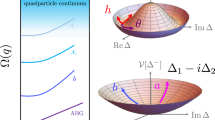Summary
A simplified approach to the field-theoretic treatment of superconductivity is developed. In addition to providing more clear derivations of known results, we derive some new results: expressions for the coupling constants of the Goldstone mode and the plasmon to the quasi-particles. Our formalism also provides a greatly simplified method for determining the specific form of current operators in terms of physical fields. This is based on the familiar fact that the matrix element of an operator density between physical states can be computed by coupling the operator density to an externalc-number field and evaluating the lowest-order transition amplitude induced by the field.
Riassunto
Si sviluppa un approccio semplificato al trattamento della superconduttività nella teoria dei campi. Oltre a fornire più chiare derivazioni dei risultati nuovi, si deducono nuovi risultati: espressioni delle costanti di accoppiamento del modo di Goldstone e del plasmone alle quasi particelle. II nostro lormalismo fornisce un metodo molto semplificato per determinare la forma specifica degli operatori di corrente in termini di campi fisici. Ciò è basato sul f atto familare che l’elemento di matrice di una densità di operatore fra stati fisici può essere calcolato accoppiando la densità dell’operatore a un campo esterno di numeroc e valutando l’ampiezza di transizione di ordine inferiore indotta dal campo.
Similar content being viewed by others
References
J. Bardeen, L. N. Cooper andJ. R. Schrieffer:Phys. Rev.,106, 162 (1957);108, 1175 (1957).
Y. Nambu:Phys. Rev.,117, 648 (1960).
J. Goldstone:Nuovo Cimento,19, 154 (1961).
P. W. Anderson:Phys. Rev.,110, 827, 1900 (1958).
L. Leplae andH. Umezawa:Nuovo Cimento,44 A, 410 (1966); L. Leplae, R. N. Sen and H. Umezawa:Problems of Fundamental Physics (Kyoto, 1965).
M. Fierz:Helv. Phys. Acta,12, 3 (1939).
R. V. Lange:Phys. Rev. Lett.,14, 3 (1965).
H. A. Bethe andE. E. Salpeter:Phys. Rev.,82, 309 (1951); M. Gell-Mann and F. E. Low:Phys. Rev.,82, 350 (1951).
D. Lurié, A. J. Macfarlane andY. Takahashi:Phys. Rev.,140, B 1091 (1965).
For other instances of the use of the normalization condition for Bethe-Salpeter amplitudes in many-body theory, seeH. Sato andK. Maki:Progr. Theor. Phys.,44, 865 (1970); N. Nakanishi:Progr. Theor. Phys., Suppl.,43, 7 (1969).
Application of this technique to dynamical-symmetry rearrangement in the rela-tivistic Nambu model is found inY. Freundlich andD. Lurié:Nucl. Phys.,18 B, 141 (1970).
Author information
Authors and Affiliations
Additional information
On leave from Physics Department, Technion-Israel Institute of Technology, Haifa.
Rights and permissions
About this article
Cite this article
Cremer, S., Sapir, M. & Lurié, D. Collective modes, coupling constants and dynamical-symmetry rearrangement in superconductivity. Nuov Cim B 6, 179–205 (1971). https://doi.org/10.1007/BF02735385
Received:
Revised:
Accepted:
Published:
Issue Date:
DOI: https://doi.org/10.1007/BF02735385



